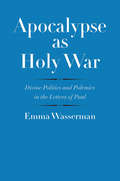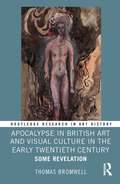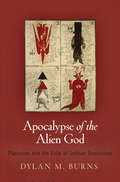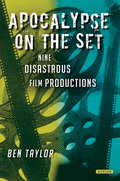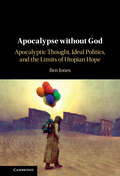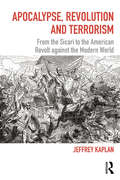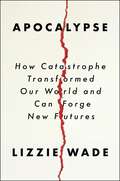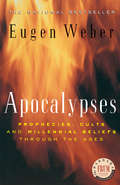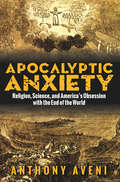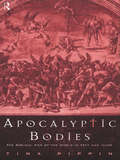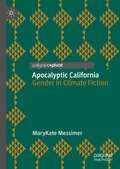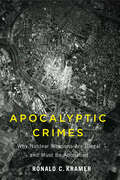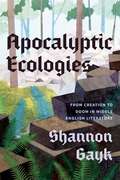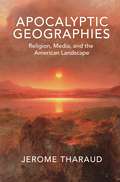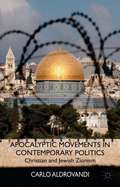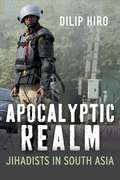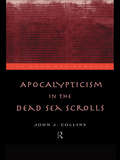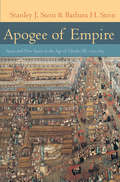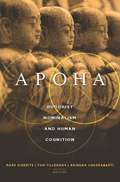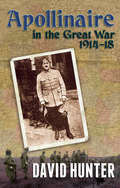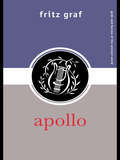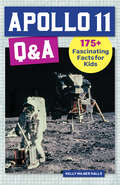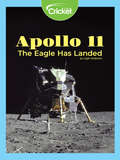- Table View
- List View
Apocalypse as Holy War: Divine Politics and Polemics in the Letters of Paul (The Anchor Yale Bible Reference Library)
by Emma WassermanPrevailing theories of apocalypticism assert that in a world that rebels against God, a cataclysmic battle between good and evil is needed to reassert God’s dominion. Emma Wasserman, a rising scholar of early Christian history, challenges this interpretation and reframes Paul’s apocalyptic texts as myths about politics in the world of divinity. Wasserman argues that the most dominant historical-critical theories about Christian apocalypticism are ahistorical and tend to work with apologetic formulations of Christ’s victory and the uniqueness of Christianity. Assessing Paul’s claims about immanent war, divine enemies, and the transformation that will accompany Christ’s return, Wasserman sees him as envisioning a single, righteously ruled cosmic kingdom, the true nature of which will soon be revealed to all. A major scholarly contribution that ranges across Mediterranean and West Asian religious thought, this volume has broad implications for understanding Paul’s myth of heroic submission as well as his most distinctive ethical teachings.
Apocalypse in British Art and Visual Culture in the Early Twentieth Century: Some Revelation (Routledge Research in Art History)
by Thomas BromwellThis book is the first substantial study of the presence and relationship with the concepts of apocalypse, eschatology, and millennium in modern British art from 1914 to 1945, addressing how and why practitioners in both religious and secular spheres turned to the subjects.The volume examines British art and visual culture’s relationship with the then-contemporary anxieties and hopes regarding the orientation of society and culture, arguing that there is an acute relationship to the particular forms of cultural discourse of eschatology, apocalypse, and millennium. Chapters identify the continued relevance of religion and religious themes in British art during the period, and demonstrate that eschatology, apocalypse, and millennium were thriving and surprisingly mainstream concepts in the period that remained vital in early to mid-twentieth-century society and culture.This book is a research monograph aimed at an audience of scholars and graduate students already familiar with the core focus of modern British art and cultural histories, especially those working on the late nineteenth and early twentieth centuries, or the concepts of apocalypse, eschatology, and millennium in Theology, Sociology, or other disciplinary settings. It will also be of interest to scholars and students working on war and visual culture, or histories of imperialism.It will benefit scholars of early twentieth-century British art, demonstrating the intersection of art and religion in the modern era, and critically qualifies the standard secular canon and narrative of modern British art, and the general neglect of religion in existing art-historical literature.
Apocalypse of the Alien God: Platonism and the Exile of Sethian Gnosticism (Divinations: Rereading Late Ancient Religion)
by Dylan M. BurnsIn the second century, Platonist and Judeo-Christian thought were sufficiently friendly that a Greek philosopher could declare, "What is Plato but Moses speaking Greek?" Four hundred years later, a Christian emperor had ended the public teaching of subversive Platonic thought. When and how did this philosophical rupture occur? Dylan M. Burns argues that the fundamental break occurred in Rome, ca. 263, in the circle of the great mystic Plotinus, author of the Enneads. Groups of controversial Christian metaphysicians called Gnostics ("knowers") frequented his seminars, disputed his views, and then disappeared from the history of philosophy—until the 1945 discovery, at Nag Hammadi, Egypt, of codices containing Gnostic literature, including versions of the books circulated by Plotinus's Christian opponents. Blending state-of-the-art Greek metaphysics and ecstatic Jewish mysticism, these texts describe techniques for entering celestial realms, participating in the angelic liturgy, confronting the transcendent God, and even becoming a divine being oneself. They also describe the revelation of an alien God to his elect, a race of "foreigners" under the protection of the patriarch Seth, whose interventions will ultimately culminate in the end of the world.Apocalypse of the Alien God proposes a radical interpretation of these long-lost apocalypses, placing them firmly in the context of Judeo-Christian authorship rather than ascribing them to a pagan offshoot of Gnosticism. According to Burns, this Sethian literature emerged along the fault lines between Judaism and Christianity, drew on traditions known to scholars from the Dead Sea Scrolls and Enochic texts, and ultimately catalyzed the rivalry of Platonism with Christianity. Plunging the reader into the culture wars and classrooms of the high Empire, Apocalypse of the Alien God offers the most concrete social and historical description available of any group of Gnostic Christians as it explores the intersections of ancient Judaism, Christianity, Hellenism, myth, and philosophy.
Apocalypse on the Set
by Ben TaylorWith sky-high budgets and competing egos, almost any film production has the potential for disaster. But some become full-fledged nightmares. Take Pulgasari - a North Korean Godzilla clone dreamed up by Kim Jong II and created by a kidnapped South Korean director, with a budget of millions and a staff of seven hundred fed on truckloads of pheasants, wild geese and deer . . . The stories behind the other eight films, from The Adventures of Baron Munchausen and The Twilight Zone: The Movie to Waterworld and The Crow, are just as astounding and as gripping. This is a book film fans will devour. These bizarre, often hilarious cinematic endeavours confirm that truth is stranger than fiction, reality more volatile than narratives, and fate more improbable than plots.
Apocalypse on the Set: Nine Disastrous Film Productions
by Ben TaylorThe book starts with Pulgasari--a North Korean Godzilla clone dreamed up by Kim Jong-Il and created by a kidnapped Korean director, with a budget of millions and a staff of seven hundred fed on truckloads of pheasants, wild geese, and deer. The stories behind the other eight films, from The Adventures of Baron Munchausen and The Twilight Zone: The Movie to Apocalypse Now and The Crow, are just as astounding and gripping--this is a book film fans will devour. These bizarre, often hilarious cinematic endeavors confirm that truth is stranger than fiction, reality more volatile than narratives, and fate more improbable than plots.
Apocalypse on the Set: Nine Disastrous Film Productions
by Ben TaylorThe book starts with Pulgasari--a North Korean Godzilla clone dreamed up by Kim Jong-Il and created by a kidnapped Korean director, with a budget of millions and a staff of seven hundred fed on truckloads of pheasants, wild geese, and deer. The stories behind the other eight films, from The Adventures of Baron Munchausen and The Twilight Zone: The Movie to Apocalypse Now and The Crow, are just as astounding and gripping--this is a book film fans will devour. These bizarre, often hilarious cinematic endeavors confirm that truth is stranger than fiction, reality more volatile than narratives, and fate more improbable than plots.
Apocalypse without God: Apocalyptic Thought, Ideal Politics, and the Limits of Utopian Hope
by Ben JonesApocalypse, it seems, is everywhere. Preachers with vast followings proclaim the world's end. Apocalyptic fears grip even the nonreligious amid climate change, pandemics, and threats of nuclear war. As these ideas pervade popular discourse, grasping their logic remains elusive. Ben Jones argues that we can gain insight into apocalyptic thought through secular thinkers. He starts with a puzzle: Why would secular thinkers draw on Christian apocalyptic beliefs – often dismissed as bizarre – to interpret politics? The apocalyptic tradition proves appealing in part because it theorizes a relation between crisis and utopia. Apocalyptic thought points to crisis as the vehicle to bring the previously impossible within reach, offering resources for navigating challenges in ideal theory, which involves imagining the best, most just society. By examining apocalyptic thought's appeal and risks, this study arrives at new insights on the limits of utopian hope. This title is available as open access on Cambridge Core.
Apocalypse, Revolution and Terrorism: From the Sicari to the American Revolt against the Modern World (Political Violence)
by Jeffrey KaplanThis book focuses on religiously driven oppositional violence through the ages. Beginning with the 1st-century Sicari, it examines the commonalities that link apocalypticism, revolution, and terrorism occurring in Judaism, Christianity, and Islam past and present. It is divided into two sections, 'This was Then' and 'This is Now', which together examine the cultural and religious history of oppositional violence from the time of Jesus to the aftermath of the 2016 American election. The historical focus centers on how the movements, leaders and revolutionaries from earlier times are interpreted today through the lenses of historical memory and popular culture. The radical right is the primary but not exclusive focus of the second part of the book. At the same time, the work is intensely personal, in that it incorporates the author's experiences in the worlds of communist Eastern Europe, in the Iranian Revolution, and in the uprisings and wars in the Middle East and East Africa. This book will be of much interest to students of religious and political violence, religious studies, history, and security studies.
Apocalypse: How Catastrophe Transformed Our World and Can Forge New Futures
by Lizzie WadeA Next Big Idea Club Must-Read Book of May 2025 • A Publishers Weekly Most Anticipated History Book of the Year • A The Millions Most Anticipated Spring Book of the Year"Lizzie Wade is an exceptional journalist and a master storyteller. She reminds us that survival always has been, and still is, possible, and that our world always has been, and still is, a choice." –Ed Yong, author of An Immense World“This book upended my understanding of the ancient world. Wade renders our deep past in vivid prose, showing us that times of great rupture also bring great possibilities for new ways of living, if we let them. Apocalypse is the best kind of history book: vibrant and vital.” —Zoë Schlanger, author of The Light EatersA richly imagined new view on the great human tradition of apocalypse, from the rise of Homo sapiens to the climate instability of our present, that defies conventional wisdom and long-held stories about our deep past to reveal how cataclysmic events are not irrevocable endings, but transformations.A drought lasts for decades, a disease rips through a city, a civilization collapses. When we finally uncover the ruins, we ask: What happened? The good news is, we’ve been here before. History is long, and people have already confronted just about every apocalypse we’re facing today. But these days, archaeologists are getting better at seeing stories of survival, transformation, and even progress hidden within those histories of collapse and destruction. Perhaps, we begin to see, apocalypses do not destroy worlds, but create them anew.Apocalypse offers a new way of understanding human history, reframing it as a series of crises and cataclysms that we survived, moments of choice in an evolution of humanity that has never been predetermined or even linear. Here Lizzie Wade asks us to reckon with our long-held narratives of these events, from the end of Old Kingdom Egypt, the collapse of the Classic Maya, to the Black Death, and shows us how people lived through and beyond them—and even considered what a new world could look like in their wake.The more we learn about apocalypses past, the more hope we have that we will survive our own. It won’t be pleasant. It won’t be fair. The world will be different on the other side, and our cultures and communities—perhaps even our species—will be different too.
Apocalypses
by Eugen WeberEugen Weber delivered the Barbara Frum Historical Lecture, based on Apocalypses, at the University of Toronto in March 1999. This annual lecture "on a subject of contemporary history in historical perspective" was established in memory of Barbara Frum.Apocalypses Prophecies, Cults and Millennial Beliefs through the AgesThe Barbara Frum Historical LectureshipA national bestsellerWhat drove eminent historian Eugen Weber to write Apocalypses? His desire to redress the historical and religious amnesia that has consigned the study of apocalyptic and millennialist thought to the lunatic fringe. An absolute belief in the end time was omnipresent until the 17th century, and retains many adherents even now. Apocalyptic visions and prophecies inspired crusades, scientific discoveries, works of art, voyages such as those of Columbus, rebellions and reforms. Elegantly written, as witty and entertaining as it is profound, Apocalypses displays Eugen Weber's talents as a stylist and historical detective; this is more a travel book of the apocalypse than a definitive academic treatment. On the eve of a billennium beset by a host of apocalyptic predictions and cults, Apocalypses offers a sympathetic review of creeds we ignore at our peril.
Apocalyptic Anxiety: Religion, Science, and America's Obsession with the End of the World
by Anthony AveniApocalyptic Anxiety traces the sources of American culture’s obsession with predicting and preparing for the apocalypse. Author Anthony Aveni explores why Americans take millennial claims seriously, where and how end-of-the-world predictions emerge, how they develop within a broader historical framework, and what we can learn from doomsday predictions of the past. The book begins with the Millerites, the nineteenth-century religious sect of Pastor William Miller, who used biblical calculations to predict October 22, 1844 as the date for the Second Advent of Christ. Aveni also examines several other religious and philosophical movements that have centered on apocalyptic themes—Christian millennialism, the New Age movement and the Age of Aquarius, and various other nineteenth- and early twentieth-century religious sects, concluding with a focus on the Maya mystery of 2012 and the contemporary prophets who connected the end of the world as we know it with the overturning of the Maya calendar. Apocalyptic Anxiety places these seemingly never-ending stories of the world’s end in the context of American history. This fascinating exploration of the deep historical and cultural roots of America’s voracious appetite for apocalypse will appeal to students of American history and the histories of religion and science, as well as lay readers interested in American culture and doomsday prophecies.
Apocalyptic Bodies: The Biblical End of the World in Text and Image
by Tina PippinApocalyptic Bodies traces the biblical notions of the end of the world as represented in ancient and modern texts, art, music and popular culture, for example the paintings of Bosch. Tina Pippin addresses the question of how far we, in the late twentieth century, are capable of reading and responding to the 'signs of the times'. It will appeal not only to those studying religion, but also to those fascinated with interpretations of the end of the world.
Apocalyptic California: Gender in Climate Fiction
by MaryKate MessimerThis book explores concepts of environmentalism and feminism in science fiction novels written by women. By extrapolating the future of climate change, the authors of these texts model how readers can apply utopian feminist and environmental theories in their own lives. Chapter One establishes an understanding of ecofeminist environmental thinking through original research conducted at the Ursula K. Le Guin archive at the University of Oregon. Chapter Two shows an example of climate change dystopia set in California in Claire Vaye Watkins’ novel Gold Fame Citrus. The final chapters explore utopian visions of queer ecologies in books by Octavia Butler and N.K. Jemisin. Because climate change is so difficult for individuals to grapple with, a new perspective is needed to survive it. The queer ecological philosophy in these novels points to a way of life that can reduce environmental harm in an era of climate change.
Apocalyptic Crimes: Why Nuclear Weapons Are Illegal and Must Be Abolished (Critical Issues in Crime and Society)
by Ronald C. KramerIn 2023, the Bulletin of the Atomic Scientists set the iconic Doomsday Clock to ninety seconds to midnight—the closest to midnight, or civilization-ending apocalypse, it has ever been. Designed at the onset of the Cold War amid new fears of atomic weapons, the Doomsday Clock is a symbolic countdown to annihilation. Now, a generation later, the world is more vulnerable than ever to the nuclear weapons it sought to warn against. In Apocalyptic Crimes, Ronald C. Kramer reconsiders the immense danger these weapons pose to humanity, examining the use, threat to use, and continued possession of nuclear weapons from a criminological perspective. Kramer argues that any country holding on to its nuclear arsenal—including the United States—is committing a criminal act. Offering a sharp rebuke to the common claim that nuclear stockpiles serve to deter the escalation of conflict, Apocalyptic Crimes emphasizes the harm caused by the mere possession of these deadly weapons. It further considers the culpability of political officials, acting as representatives of the state, whose threatening statements about nuclear weapons contain actions or omissions that violate specific international laws. But Kramer also shows how a nuclear apocalypse might be averted and offers a pathway to disarmament. Through critical analysis and a specific criminology of nuclear weapons, Kramer outlines the political actions necessary to rewind the Doomsday Clock and pull the world back from the brink of destruction—before the clock strikes midnight.
Apocalyptic Ecologies: From Creation to Doom in Middle English Literature
by Shannon GaykA meditative reflection on what medieval disaster writing can teach us about how to respond to the climate emergency. When a series of ecological disasters swept medieval England, writers turned to religious storytelling for precedents. Their depictions of biblical floods, fires, storms, droughts, and plagues reveal an unsettled relationship to the natural world, at once unchanging and bafflingly unpredictable. In Apocalyptic Ecologies, Shannon Gayk traces representations of environmental calamities through medieval plays, sermons, and poetry such as Cleanness and Piers Plowman. In premodern disaster writing, she recovers a vision of environmental flourishing that could inspire new forms of ecological care today: a truly apocalyptic sensibility capable of seeing in every ending, every emergency a new beginning waiting to emerge.
Apocalyptic Geographies: Religion, Media, and the American Landscape
by Jerome TharaudHow nineteenth-century Protestant evangelicals used print and visual media to shape American cultureIn nineteenth-century America, "apocalypse" referred not to the end of the world but to sacred revelation, and "geography" meant both the physical landscape and its representation in printed maps, atlases, and pictures. In Apocalyptic Geographies, Jerome Tharaud explores how white Protestant evangelicals used print and visual media to present the antebellum landscape as a “sacred space” of spiritual pilgrimage, and how devotional literature influenced secular society in important and surprising ways.Reading across genres and media—including religious tracts and landscape paintings, domestic fiction and missionary memoirs, slave narratives and moving panoramas—Apocalyptic Geographies illuminates intersections of popular culture, the physical spaces of an expanding and urbanizing nation, and the spiritual narratives that ordinary Americans used to orient their lives. Placing works of literature and visual art—from Thomas Cole’s The Oxbow to Harriet Beecher Stowe’s Uncle Tom’s Cabin and Henry David Thoreau’s Walden—into new contexts, Tharaud traces the rise of evangelical media, the controversy and backlash it engendered, and the role it played in shaping American modernity.
Apocalyptic Movements in Contemporary Politics
by Carlo AldrovandiThis book explores Israeli Religious Zionism and US Christian Zionism by focusing on the Messianic and Millenarian drives at the basis of their political mobilization towards a 'Jewish colonization' of the occupied territories.
Apocalyptic Realm
by Dilip HiroThis hard-hitting and timely book explores the roots of militant Islam in South Asia and how it has grown to become a source of profound global alarm. By meticulously tracking the rise of the jihadist movement from its initial violence in Afghanistan in 1980 to the present day, Dilip Hiro challenges conventional narratives of the roles of Afghanistan, Pakistan, the Soviet Union, the United States, and India. He warns that the Line of Control in Kashmir, where jihadists seek to incite war between nuclear-armed Pakistan and India, is today the most dangerous border in the world. Drawing on evidence from a wide variety of sources including newly released Kremlin archives and classified U. S. Embassy documents published by WikiLeaks, the author compiles the first complete and accurate history of Islamist terrorism in South Asia. He chronicles historic links between Pakistan, Afghanistan, and India and their varying degrees of destabilization at the hands of the jihadists. He also sheds unprecedented light on the close military and intelligence links that have developed between India and Israel. Finally, he outlines the ambitions of Pakistani, Afghan, and Al Qaeda jihadists to establish an "apocalyptic realm" covering South, Central, and Western Asia. Compact, comprehensive, and fast paced, this book lays bare the causes of today's escalating terrorist threat, sets the historical record straight, and offers fresh strategies for defeating jihadist extremism.
Apocalypticism in the Dead Sea Scrolls (The Literature of the Dead Sea Scrolls)
by John J. CollinsSince the photographs of the Dead Sea Scrolls were released in 1992, there has been an explosion of interest in them. This volume explores the issue of apocalypticism in the Scrolls; how the notions of the 'end', Messianic expectation and eternal life affected the Dead Sea sect, influenced Judaism and filtered into Christianity. Collins' volume provides a valuable and accessible introduction to the interpretation of the Scrolls, which is an informative addition to the series examining the major themes of the Scroll texts.
Apogee of Empire: Spain and New Spain in the Age of Charles III, 1759–1789
by Stanley J. Stein Barbara H. SteinOnce Europe's supreme maritime power, Spain by the mid-eighteenth century was facing fierce competition from England and France. England, in particular, had successfully mustered the financial resources necessary to confront its Atlantic rivals by mobilizing both aristocracy and merchant bourgeoisie in support of its imperial ambitions. Spain, meanwhile, remained overly dependent on the profits of its New World silver mines to finance both metropolitan and colonial imperatives, and England's naval superiority constantly threatened the vital flow of specie.When Charles III ascended the Spanish throne in 1759, then, after a quarter-century as ruler of the Kingdom of the Two Sicilies, Spain and its colonial empire were seriously imperiled. Two hundred years of Hapsburg rule, followed by a half-century of ineffectual Bourbon "reforms," had done little to modernize Spain's increasingly antiquated political, social, economic, and intellectual institutions. Charles III, recognizing the pressing need to renovate these institutions, set his Italian staff—notably the Marqués de Esquilache, who became Secretary of the Consejo de Hacienda (the Exchequer)—to this formidable task.In Apogee of Empire, Stanley J. Stein and Barbara H. Stein trace the attempt, initially under Esquilache's direction, to reform the Spanish establishment and, later, to modify and modernize the relationship between the metropole and its colonies. Within Spain, Charles and his architects of reform had to be mindful of determining what adjustments could be made that would help Spain confront its enemies without also radically altering the Hapsburg inheritance. As described in impressive detail by the authors, the bitter, seven-year conflict that ensued between reformers and traditionalists ended in a coup in 1766 that forced Charles to send Esquilache back to Italy. After this setback at home, Charles still hoped to effect constructive change in Spain's imperial system, primarily through the incremental implementation of a policy of comercio libre (free-trade). These reforms, made half-heartedly at best, failed as well, and by 1789 Spain would find itself ill prepared for the coming decades of upheaval in Europe and America.An in-depth study of incremental response by an old imperial order to challenges at home and abroad, Apogee of Empire is also a sweeping account of the personalities, places, and policies that helped to shape the modern Atlantic world.
Apoha: Buddhist Nominalism and Human Cognition
by Mark Tom Tillemans Arindam Chakrabarti Eds. SideritsWhen we understand that something is a pot, is it because of one property that all pots share? This seems unlikely, but without this common essence, it is difficult to see how we could teach someone to use the word "pot" or to see something as a pot. The Buddhist apoha theory tries to resolve this dilemma, first, by rejecting properties such as "potness" and, then, by claiming that the element uniting all pots is their very difference from all non-pots. In other words, when we seek out a pot, we select an object that is not a non-pot, and we repeat this practice with all other items and expressions.Writing from the vantage points of history, philosophy, and cognitive science, the contributors to this volume clarify the nominalist apoha theory and explore the relationship between apoha and the scientific study of human cognition. <P><P>They engage throughout in a lively debate over the theory's legitimacy. Classical Indian philosophers challenged the apoha theory's legitimacy, believing instead in the existence of enduring essences. Seeking to settle this controversy, essays explore whether apoha offers new and workable solutions to problems in the scientific study of human cognition. They show that the work of generations of Indian philosophers can add much toward the resolution of persistent conundrums in analytic philosophy and cognitive science.
Apollinaire in the Great War (1914-18)
by David HunterA major literary figure in pre-war Paris, Guillaume Apollinaire volunteered for war in 1914, trained as an artilleryman and was posted in April 1915 to the Champagne front in northern France, participating in the bloody but little-known offensive that September and then moving into the front line as an infantry officer, before being wounded in March 1916 and invalided out of active service. Back in Paris, Apollinaire plunged back into the activities of the capital's artistic avant-garde, meanwhile publishing poetry, prose and plays that were deeply influenced by his involvement in the conflict. He died on 9 November 1918, two days before the Armistice, a victim of the influenza pandemic, but with a literary reputation secured, as well as a certain fame for coining the term 'Surrealism'. This book draws heavily on Apollinaire's writings to tell the story of his war years, within the wider context of the French experience of the Great War. In this period, Apollinaire also wrote hundreds of letters, the bulk of them to two women: Louise de Coligny, a flighty socialite of aristocratic origin, and Madeleine Pagès, a young schoolteacher. In these letters he poured out his passionate feelings for both in often highly erotic poetry and prose, as well as giving detailed descriptions of his life as a front-line soldier.
Apollo (Gods and Heroes of the Ancient World)
by Fritz GrafFritz Graf here presents a survey of a god once thought of as the most powerful of gods, and capable of great wrath should he be crossed: Apollo the sun god. From his first attestations in Homer, through the complex question of pre-Homeric Apollo, to the opposition between Apollo and Dionysos in nineteenth and twentieth-century thinking, Graf examines Greek religion and myth to provide a full account of Apollo in the ancient world. For students of Greek religion and culture, of myth and legend, and in the fields of art and literature, Apollo will provide an informative and enlightening introduction to this powerful figure from the past.
Apollo 11 Q&A: 175+ Fascinating Facts for Kids (History Q&A)
by Kelly Milner Halls175+ fascinating facts that teach kids ages 8 to 12 how we got to the moon From cube-shaped astronaut foods to the famous moon walk, there are so many incredible things for kids to learn about the Apollo 11 mission. This engaging guide introduces kids to the legacy of Apollo 11 through short, fun Q&As. They'll see how awesome learning can be as they read about spaceships, astronauts, space suits, and more—one easy-to-understand answer at a time. Go beyond other Apollo 11 books for kids with: New ways to learn—Launch kids into the history of the Apollo 11 mission with Q&As, true or false questions, and fun facts. Shareable history—This book is packed full of bite-sized bits of history that are both memorable and exciting for kids to tell their friends and family. A complete overview—From the start of the space race to the ways the Apollo 11 mission still affects modern space travel, kids will get a comprehensive look at America's space program. Spark a lifelong love of history in young astronauts with this top choice in space books for kids.
Apollo 11: The Eagle Has Landed
by Leigh AndersonHave you ever looked into the night sky and wished that you could walk on the Moon? Find about what it is like from the astronauts that were first to do it! Learn about how Neil Armstrong, Edwin Aldrin, and Michael Collins traveled into space and created history in 1969, and what it was like to take those famous first steps that made “one giant leap for mankind."
